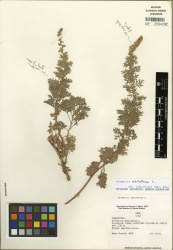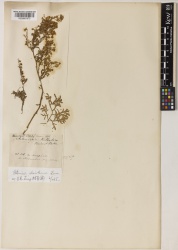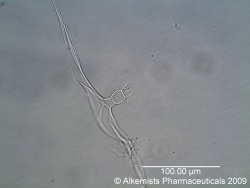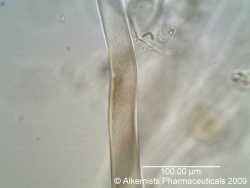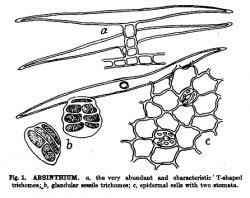Artemisia absinthium (leaf)
(add additional organoleptic, macroscopic information) |
|||
| (14 intermediate revisions by 4 users not shown) | |||
| Line 1: | Line 1: | ||
| − | + | {{DISPLAYTITLE:'' Artemisia absinthium'' (leaf) }} {{askbox|herb=''Artemisia absinthium''}} | |
| − | '' | + | |
| − | + | =Nomenclature= | |
| − | + | {{nomenclature | binomial=Artemisia absinthium | |
| + | |authority=L. | ||
| + | |family=Asteraceae | ||
| + | |scn=wormwood | ||
| + | |syn= | ||
| + | |ayurvedic= | ||
| + | |pinyin= | ||
| + | |aka= | ||
| + | |notes= }} | ||
| − | + | =Botanical Voucher Specimen= | |
| − | + | {{Media2 | cat=Voucher | |
| − | = | + | |
| − | = | + | | source=MOBOT, Tropicos.org |
| − | {{ | + | | mainimage=Artemisia absinthium Tropicos 100158913.jpg |
| − | + | | companyimage=TropicosLogo.gif | |
| − | + | | companyURL=http://www.tropicos.org/Image/100158913 | |
| − | + | | reference=Tropicos.org. Missouri Botanical Garden. 06 Aug 2013 <http://www.tropicos.org/Image/100158913> | |
| + | |||
| + | | companyimage2=Kewlogo.gif | ||
| + | | companyURL2=http://specimens.kew.org/herbarium/K000891973 | ||
| + | | image2=Artemisia_absinthium_Kew_imageBarcode=K000891973_481570.jpg | ||
| + | | source2=Royal Botanic Gardens, Kew. | ||
| + | |||
| + | | }} | ||
| + | |||
| + | =Organoleptic Characteristics= | ||
| + | {| border=1 | ||
| + | | | ||
| + | {{Organolepsy| source=Schneider, A. (1921) The Microanalysis of Powdered Vegetable Drugs, 2nd ed. | ||
| + | |description= | ||
| flavor=Very bitter, somewhat saline. | | flavor=Very bitter, somewhat saline. | ||
| − | | scent=Faintly aromatic, disagreeable and narcotic when briskly rubbed. | + | | scent=Faintly aromatic, disagreeable and narcotic when briskly rubbed.}} |
| + | |||
| + | {{Organolepsy | source=American Medicinal Plants of Commercial Importance (1930) | ||
| + | | scent=The plant has an aromatic odor. | ||
| + | | flavor=[Wormwood has] an exceedingly bitter taste.}} | ||
| + | |} | ||
| + | =Macroscopic Characteristics= | ||
| + | {| border=1 | ||
| + | | | ||
| + | {{Macroscopy | source=American Medicinal Plants of Commercial Importance (1930) | ||
| + | | description=This shrubby, aromatic, much-branched plant grows from 2 to 4 feet in height. The growing shoots are silvery white with fine silky hairs; and the grayish-green leaves, which are from 2 to 5 inches long, are divided into small leaflets. The flower clusers, appearing from July to October, consist of numerous small, insignificant, drooping, yellow heads. | ||
| + | }} | ||
| + | {{Macroscopy| source=Schneider, A. (1921) The Microanalysis of Powdered Vegetable Drugs, 2nd ed. | ||
| + | |description= | ||
| + | | color=Grayish green.}} | ||
| + | |} | ||
| + | =Microscopic Characteristics= | ||
| + | {| border=1 | ||
| + | | | ||
| + | {{Microscopy | source=Schneider, A. (1921) The Microanalysis of Powdered Vegetable Drugs, 2nd ed. | ||
| characteristics=The most distinctive tissue elements are the very abundant T-shaped, rather thin-walled trichromes with three to four basal cells; the rather large, yellowish, sessile, glandular trichromes with several vertical tiers of cells, are also quite diagnostic some pollen grains presenting the characteristics of the pollen of the order Compositae will generally be found. The vertical walls of the epidermal cells are wavy or sinuate and the stomata are abundant and fairly large. | | characteristics=The most distinctive tissue elements are the very abundant T-shaped, rather thin-walled trichromes with three to four basal cells; the rather large, yellowish, sessile, glandular trichromes with several vertical tiers of cells, are also quite diagnostic some pollen grains presenting the characteristics of the pollen of the order Compositae will generally be found. The vertical walls of the epidermal cells are wavy or sinuate and the stomata are abundant and fairly large. | ||
| Line 24: | Line 63: | ||
| }} | | }} | ||
| − | {{ | + | {{Media3 | cat=Microscopy |
| mainimage=Artemisia_absinthium_L._-Asteraceae--1.jpg | | mainimage=Artemisia_absinthium_L._-Asteraceae--1.jpg | ||
| − | | description= | + | | source=Elan M. Sudberg, Alkemist Laboratories |
| + | | companyimage=AP-LOGO-Laboratories Crop - Copy.jpg | ||
| + | | companyURL=http://www.alkemist.com/ | ||
| + | | description=Wormwood (leaf) (''Artemisia absinthium'') | ||
| caption1=T-shaped trichromes with three to four basal cells in 400X Acidified chloral Hydrate Soln. | | caption1=T-shaped trichromes with three to four basal cells in 400X Acidified chloral Hydrate Soln. | ||
| − | | characteristics=The most distinctive tissue elements are the very abundant T-shaped, rather thin-walled trichromes with three to four basal cells as well as the strap-shaped tubular covering trichomes | + | | characteristics=The most distinctive tissue elements are the very abundant T-shaped, rather thin-walled trichromes with three to four basal cells, as well as the strap-shaped tubular covering trichomes when observed at 400X with Acidified chloral Hydrate Soln. |
| + | | source2=Elan M. Sudberg, Alkemist Laboratories | ||
| + | | companyimage2=AP-LOGO-Laboratories Crop - Copy.jpg | ||
| + | | companyURL2=http://www.alkemist.com/ | ||
| image2=Artemisia_absinthium_L._-Asteraceae--2.jpg | | image2=Artemisia_absinthium_L._-Asteraceae--2.jpg | ||
| − | | caption2= | + | | companyimage=AP-LOGO-Laboratories Crop - Copy.jpg |
| − | | }} | + | | caption2=Fragment of a strap-shaped tubular covering trichrome |
| − | = | + | | reference=British Pharmacopoeia, 2003 |
| − | = | + | | source3=Schneider, A. (1921) The Microanalysis of Powdered Vegetable Drugs, 2nd ed. |
| + | | image3=Microanalysis_powdered_vegetable_p_200_google_ver_absinthium_figure.png | }} | ||
| + | |} | ||
| + | |||
| + | =High Performance Thin Layer Chromatographic Identification= | ||
| + | |||
| + | =Supplementary Information= | ||
| + | |||
| + | =Sources= | ||
| + | |||
| + | <references /> | ||
Latest revision as of 13:34, 24 June 2015
Contents |
Nomenclature
Artemisia absinthium L. Asteraceae
Standardized common name (English): wormwood
Botanical Voucher Specimen
 |
|
|
|
|
Organoleptic Characteristics
|
Macroscopic Characteristics
|
Microscopic Characteristics
|
High Performance Thin Layer Chromatographic Identification
Supplementary Information
Sources
- ↑ MOBOT, Tropicos.org http://www.tropicos.org/Image/100158913
- ↑ Royal Botanic Gardens, Kew. http://specimens.kew.org/herbarium/K000891973
- ↑ Schneider, A. (1921) The Microanalysis of Powdered Vegetable Drugs, 2nd ed.
- ↑ American Medicinal Plants of Commercial Importance (1930)
- ↑ American Medicinal Plants of Commercial Importance (1930)
- ↑ Schneider, A. (1921) The Microanalysis of Powdered Vegetable Drugs, 2nd ed.
- ↑ Schneider, A. (1921) The Microanalysis of Powdered Vegetable Drugs, 2nd ed.
- ↑ Elan M. Sudberg, Alkemist Laboratories http://www.alkemist.com/
- ↑ Elan M. Sudberg, Alkemist Laboratories http://www.alkemist.com/
- ↑ Schneider, A. (1921) The Microanalysis of Powdered Vegetable Drugs, 2nd ed.
